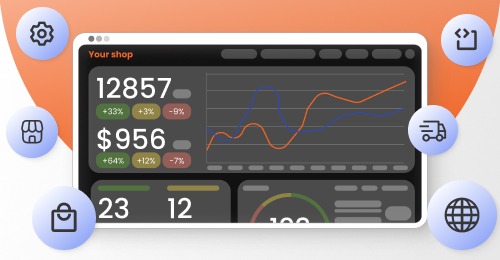While the eCommerce industry is continually expanding, dominating the digital environment becomes paramount for merchants to stay on consumers’ radars. Search Engine Optimization (SEO) aids businesses in securing a prominent place in search rankings and raising organic traffic to their websites.
How exactly does eCommerce website SEO help online retailers elevate their visibility and advance their businesses?
The first five results on the search results page get over 67% of all the clicks. At the same time, over 90% of content doesn’t receive any traffic from Google. Therefore, getting into those lucky 10% and, even more so, hitting the desired top five on the first SERP page is what aids your site in outperforming the competition.
SEO strategies entail a prolonged effect, meaning that once you have invested in your shop’s initial optimization, you can continue receiving traffic for months or even years to come. You just need to continue fine-tuning your online space to keep up with the continually evolving search mechanisms.
Here, an SEO audit enters the scene. It serves as a strategic roadmap to uncover gaps, secure advantages, and boost your site’s rankings. Join us to grasp the intricacies of an eCommerce SEO audit and get a vision of how to cut through the crowded digital marketplace.
A short introduction to the authors, WebMeridian’s eCommerce SEO experts, of this comprehensive article:
- Oleksandr Kryvotsiuk, an eCommerce SEO expert with over 10 years of experience, focuses on search engine optimization and marketing strategies. Oleksandr has extensive practical experience in developing online store structures, conducting eCommerce SEO audits, fixing technical errors, and link building.
- Veronika Kovalska, an eCommerce marketer with over 5 years of experience, specializes in branding and digital strategies, implementing effective SEO techniques to optimize sites and drive targeted traffic to Magento stores.
- What is an eCommerce SEO Audit? Why Should You Regularly Check Your eCommerce Website?
- eCommerce SEO Audit Checklist: Essential Steps and Tools for Success
- eCommerce SEO Audit: Why It’s Crucial – A Real-Life Example
- Example of an eCommerce SEO Audit
- eCommerce SEO Audit Services: What Tasks Are Included?
- How to Define Your Time for an SEO Audit
- 6 Things to Check to Boost Rankings
- How to Set the Right Regularity for an SEO Audit?
- Conclusion
Briefly about the main thing
Did you know that 95% of online stores miss out on 3/4 of their search traffic? It happens due to mistakes made by site owners or developers during the launch stage. And it doesn't matter what platform or technology the online store was built on.
Begin eCommerce Website Optimization
The structure of a website is akin to the foundation of a house. Lay a solid groundwork for your business's growth with a properly configured store.

What is an eCommerce SEO Audit? Why Should You Regularly Check Your eCommerce Website?
An eCommerce SEO site audit implies a detailed evaluation of an online shop in terms of its location in the search. The assessment encompasses various parameters and aims to reveal performance gaps, raise the site’s rankings, and elevate traffic and sales.
Why are routine eCommerce SEO audits necessary?
The core determinant of your site’s seamless operation is the ability to match user aspirations and continually upgrade search mechanisms. Google assesses more than 200 ranking parameters to index your page, and this number is relentlessly growing. A failure to keep pace with those parameters may lead to declining traffic and, ultimately, lower profits.
Conversely, if you regularly do an eCommerce website SEO audit, it facilitates your website’s welfare and guarantees the absence of errors and compliance with the recent upgrades in search bots. An SEO inspection is also a handy method to detect early flaws, countering their transformation into serious issues.
Essentially, routine eCommerce store SEO audits can grant you several upsides:
- Detecting and removing mistakes according to the inspection results empowers you to raise rankings and conversions.
- Retaining a competitive transcendence. SEO audit for eCommerce sites assists businesses in adjusting to altering consumer behaviors.
- Obtaining measurable performance results. SEO inspections help you estimate the efficiency of your current activities and revise the strategies to align them with your business objectives.
eCommerce SEO Audit Checklist: Essential Steps and Tools for Success
To thrive in the competitive eCommerce landscape, your website must be optimized for search engines. This eCommerce SEO audit checklist outlines the essential steps and tools to help you achieve top rankings and drive targeted traffic to your online store. Check your site in the following areas:
- Website security
- Technical SEO
- Content
- Backlink profile
| Description | Best Tools | Issues | |
|---|---|---|---|
| Website Security | When your security certificate expires, visitors will see a "not secure" warning, potentially reducing trust and traffic. | SE Ranking, Website Security Validator (ImmuniWeb) | Yes/No |
| Security certificate expires soon | Using an outdated SSL or TLS protocol (version 1.0) can compromise website data security. | Yes/No | |
| Certificate name mismatch | If the SSL certificate name doesn't match the address bar, visitors will see a "not secure" warning, leading to potential loss of trust and traffic. | Yes/No | |
| Outdated encryption algorithm | Outdated encryption algorithms can cause browsers to warn visitors of insecure content, leading to a loss of trust and traffic. | Yes/No | |
| HTTP URLs in XML sitemap | Transfer your site to HTTPS if it's using HTTP, and ensure HTTPS URLs are in the XML sitemap if already using HTTPS. | Yes/No | |
| No HTTPS encryption | HTTP is outdated and lacks encryption, causing modern browsers to tag HTTP sites as not secure, leading to a loss of visitor trust. | Yes/No | |
| rel="canonical" from HTTPS to HTTP | The rel="canonical" attribute on some HTTPS pages points to HTTP versions, which are unsafe and affect search engine ranking; move all pages to HTTPS. | Yes/No | |
| Redirect from HTTPS to HTTP | Redirecting HTTPS pages to HTTP makes the site insecure, risking data interception and affecting search engine ranking. | Yes/No | |
| Latest CMS/Technology version | Checking the CMS/Technology version | Yes/No | |
| Logs | Detection of server codes 4XX, 5XX, SSL/TLS Errors, Timeout Errors, etc. | Yes/No | |
| Web Application Firewall (WAF) | Not configured WAR to protect your site from common web threats such as SQL injection, XSS, and DDoS attacks | Yes/No | |
| Automated Backups | Not configured backups. | Yes/No | |
| Security Extensions | Not configured Security Extensions/Apps | Yes/No | |
| Secure Admin Panel (2FA) | Not configured Two-Factor Authentication (2FA) | Yes/No | |
| Technial SEO | |||
| XML sitemap | Detected Non-canonical pages/Noindex pages in XML sitemap. | XML Sitemap Validator, SE Ranking | Yes/No |
| Robots.txt | Detected in Robots.txt file:
| Google Search Console (robots.txt report), SE Ranking | Yes/No |
| Search Engine Friendly URLs | URLs look unclear and contain capital letters, numbers, and symbols (?, #, ...) | SEO Friendly URL CheckerSEO Friendly URL Checker | Yes/No |
| Canonical URLs | Absence or errors in the Canonical attribute, which indicates to search engines the main version of the page URL | Canonical Tag Checker | Yes/No |
| Website Speed | Low page loading speed | PageSpeed Insights, GTmetrix | Yes/No |
| No http/www/index.html/Uppercase URL Characters redirect | Not configured rules for automatic 301 redirects ` | SE Ranking | Yes/No |
| Categories, subcategories in the index | All categories and subcategories are visible in the search | Google Search Console | Yes/No |
| Internal links, orphan pages (pages without internal links) | Pages with no internal links are detected | Google Search Console (Links report), | Yes/No |
| Hreflang (multi language website) | Hreflang attributes contain errors or are missing | Hreflang Tag Checker | Yes/No |
| Structured data markup | Structured data markup on the site pages (Product, Review, Ratings, WebSite, VideoObject) contains errors or is missing | Schema Markup Testing Tool | Yes/No |
| Self-referencing link | Pages containing links to themselves have been detected | Yes/No | |
| Content | |||
| HTML meta tag | Detected duplicate meta tags, empty fields, and filling errors | SE Ranking, Screaming Frog | Yes/No |
| H1-H2 header tags | Duplicates in the H1-H2 headers, empty fields, and filling errors were detected | SE Ranking, Screaming Frog | Yes/No |
| Unique content in categories, subcategories. AI-generated content. | Non-unique, AI-generated content is detected | Plagiarism Checker by Grammarly, Duplichecker | Yes/No |
| Backlink Profile | |||
| Toxic links | Toxic links that negatively affect the external optimization of an online store have been detected | Ahrefs, SE Ranking, Semrush, Moz | Yes/No |
| Domain Rating (DR), Domain Authority (DA) | The online store has low "authority" and there is no dynamics of increasing the link mass | Ahrefs, SE Ranking, Semrush, MozBar | Yes/No |
eCommerce SEO Audit: Why It’s Crucial – A Real-Life Example
Many eCommerce store owners underestimate the role of an eCommerce SEO audit and perform them irregularly. We always advise our clients to conduct a technical SEO audit immediately after major site changes and systematically—at least twice a year.
One SEO mistake could cost you half your traffic overnight. Let’s make sure that doesn’t happen.
This real-life case study highlights two critical lessons for online store owners:
- Not all technical changes lead to positive results. Without proper testing, even well-intended updates can hurt performance.
- Neglecting regular SEO audits can be costly. A single overlooked issue can significantly impact traffic and revenue.
That’s exactly what happened to one workwear eCommerce store that reached out to us in October. We received a request to conduct an SEO audit for eCommerce site. The client reported a drop in sales. Over the past six months, the store had generated three times less revenue than the previous year’s period.
Although we’re bound by an NDA, we can share these key details:
- Industry: Workwear eCommerce
- Location: Europe
- Platform: WooCommerce
- Goal: Understand why the website’s traffic and sales dropped three times.
Results of Our eCommerce SEO Audit
After analyzing the store’s data, we discovered:
- 69% of users accessed the store via mobile.
- The main product category accounted for 70% of total traffic.
- Traffic and sales declined as the average ranking of the main category dropped.
- User engagement metrics worsened significantly (-18.28% session duration, -23.4% active sessions per user).
- The most significant ranking drop occurred between June and August 2024.

In June 2024, Google completed the June 2024 Spam Update, which aimed to detect backlink abuse. Initially, we suspected that the ranking drop was caused by a Google penalty related to link-building, as the client had been actively working on increasing their backlink profile.
However, after conducting a backlink audit, we found no critical violations or any correlation between link-building efforts and the drop in rankings.
Issue #1
Since 69% of the store’s users interacted with the mobile version, we focused on on-site changes made before or during June–August 2024, which could have negatively affected user behavior metrics. A decline in user experience was likely a key factor behind the drop in rankings, traffic, and sales.
Imagine walking into a store, but the door is jammed. Frustrating, right? That’s how users feel when your mobile site is clunky—and Google takes note.
During our eCommerce SEO site audit, we analyzed category pages and uncovered a hidden UX issue:
- Some categories did not display product listings, showing only subcategory links and SEO text.
- Others pushed product listings too far down, forcing users to scroll past banners, sliders, and brand logos before seeing any products.
This structure conflicted with user behavior expectations. When a user enters a category, their primary goal is to view products, not additional content.
We also reviewed all the development tasks completed before and during the ranking drop and found a direct correlation between category structure changes and traffic loss. The development team moved product listings lower on the page, which likely negatively impacted user behavior metrics and rankings.
Issue #2
Another change that contributed to the ranking drop was the cookie banner design. Google required all Eurozone websites to adopt Consent Mode V2 by July 2024, requiring users’ prior consent for behavior tracking.
In June 2024, the client implemented Cookiebot’s Consent Mode V2 on their store.

By default, the cookie banner covered 90% of the screen on mobile devices, hiding the main content. As a result:
- Bounce rate increased significantly. When new users first visited the site, they did not see relevant content in the first seconds, which forced many of them to leave the page immediately.
- Google interpreted this as a poor user experience, which further harmed rankings.
How We Fixed It & What You Can Learn
After diagnosing the core issues, we implemented two key fixes:
- Reduced the cookie banner’s footprint. Instead of taking up 90% of the screen, it was scaled down to just 40%, giving users immediate access to content.
- Optimized category pages. We ensured that products were visible right away—no excessive scrolling, no buried listings.
These fixes not only made the site more user-friendly but also helped recover lost rankings, traffic, and sales.

eCommerce SEO Audit Checklist:
- User behavior impacts SEO rankings. Google rewards sites that make navigation effortless. If users struggle, rankings suffer.
- Logical category structures improve user experience. The golden rule: products first, everything else second. Think like your customers: they come to browse products, not scroll past unnecessary content.
- Every update needs an SEO strategy. Even well-intended changes can backfire if not tested properly.
- Expert insights save businesses. Before implementing major site modifications, consult a Magento SEO expert to avoid critical mistakes.
Fix Your SEO Issues with eCommerce SEO Audit
Small mistakes can cost you big. Let our SEO team help you optimize your store’s structure, improve user experience, and recover lost traffic.

Example of an eCommerce SEO Audit
To maintain readability, we summarize the key points of the eCommerce SEO audit, highlighting fundamental mistakes and providing essential recommendations.
Recently, our eCommerce SEO experts conducted a comprehensive SEO audit for an Irish online store specializing in musical instruments and accessories. The audit focused on three key areas: category content, technical site condition, and external link optimization. Several issues were identified that negatively impacted the store’s visibility in Google search results and organic traffic generation. Let’s dive deeper into the eCommerce website audit and recommendations.
Lack of subcategories
Subcategories that would match user queries with specifications are absent from categories such as https://**************/shop-by-category/guitars/electric.html. Examples of such queries include:
- black guitar electric
- red electric guitar
- electric guitar for beginners
- childs electric guitar
- yamaha electric guitar
- left handed electric guitars
- irish electric guitar
- cheapest electric guitar
- 12 string guitar electric
The website should have distinct subcategories for these kinds of searches so that users can go straight from Google search results to pages that only have the products they are interested in.
The error’s explanation can be found in this YouTube video.
Dynamic URLs
The website uses dynamic URLs for subcategories, such as https://**************/shop-by-category/guitars/electric.html?manufacturer=47. These URLs are not indexed by Google, resulting in no impressions or traffic. A detailed explanation of the error by our SEO experts can be found in this YouTube video.
Proper subcategory implementation example:
- Category: https://onlinestoreexample.com/electric-guitars
- Subcategories:
- https://onlinestoreexample.com/electric-guitars/black
- https://onlinestoreexample.com/electric-guitars/fender
- https://onlinestoreexample.com/electric-guitars/left-handed

Implementing this could boost traffic by 8-10 times, based on competitor analysis, with 27-40K organic visits per month. Therefore, we recommend:
- Analyze search queries to understand user behavior.
- Create a relevant page structure with a clear hierarchy (category, subcategory).
- Implement the correct webshop structure for SEO.
Category Errors
Categories contain errors that reduce the site’s visibility in Google search or display irrelevant queries. For instance, the category https://**************/shop-by-category/guitars/electric.html appears for irrelevant queries like “guitars” and “guitars for sale Ireland”.

This category should target electric guitar-related searches. Example of correct category display: https://www.**************/Guitars.html

Not Configured Meta-Data

1 – Title not configured according to SEO rules.
2 – Description is missing.
SEO Content
Enhancing categories with SEO content makes the page theme easier for search engines to comprehend. **************/Guitars.html, for instance.

The category backlinks
External links from authoritative sites to categories improve Google search rankings.
Backlink profile for the category https://**************/shop-by-category/guitars/electric.html VS https://**************/Guitars.html.
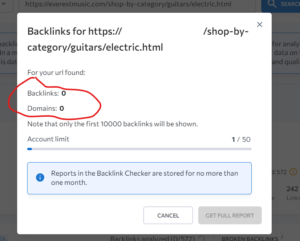
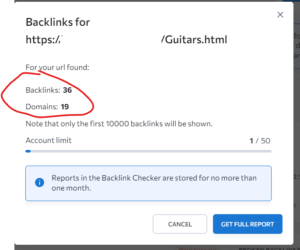
Structured Data Not Configured
Structured data helps search engines understand your page. Mistakes include: missing structured data for products, reviews, ratings, websites, and Breadcrumb. Why add structured data: Google’s Structured Data Guide.

Recommendations:
- Correct category errors (meta-data, SEO content, etc.).
- Increase category backlink mass and brand mentions through outreach articles, crowd links, etc.
Free Thorough SEO Audit
Skilled eCommerce SEO experts will analyze your online store for over 120 different parameters. Say goodbye to site crashes with eCommerce SEO audit.

Health Score

XML sitemap not found in robots.txt file

The robots.txt file must include a line linking to the sitemap.xml file. An example of this entry is Sitemap: https://…/sitemap.xml. This directive assists search engines in locating the sitemap.
URLs with a double slash
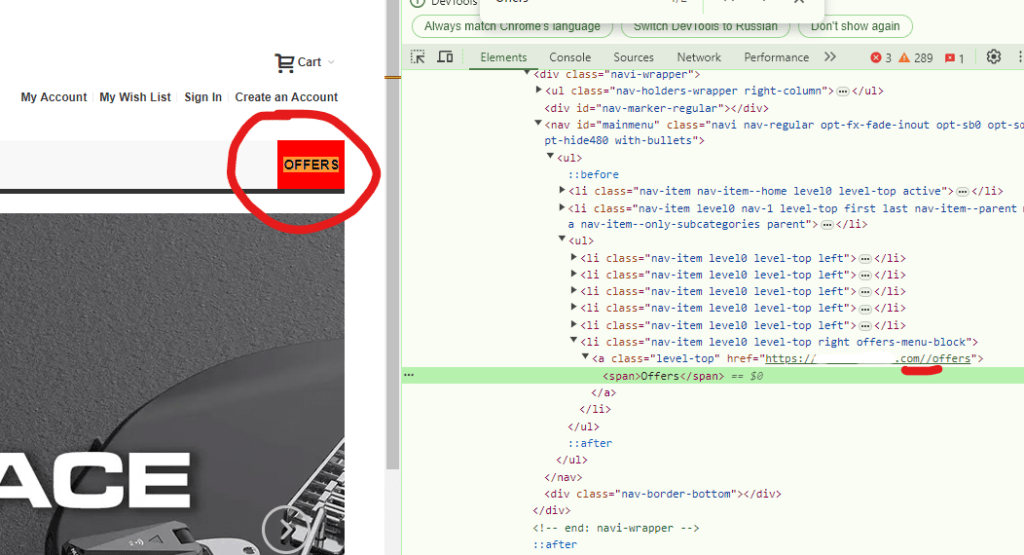
Links with double slashes, like https://…//offers, can be found on 998 pages. These URLs need to be changed to https://…/offers as they are incorrect. Multiple slashes in URLs other than the domain name are ignored by most servers, but search engines may treat them as distinct URLs, which could result in duplicate content problems.
External links to 3XX

The link appearance is incorrect because the URL is generated via an insecure protocol (HTTP), causing the page to load through a 301 redirect.

301 redirects are acceptable and useful in some cases, but it is preferable to avoid them when direct links can be used.
URLs with duplicate page titles/Duplicate description/Description missing
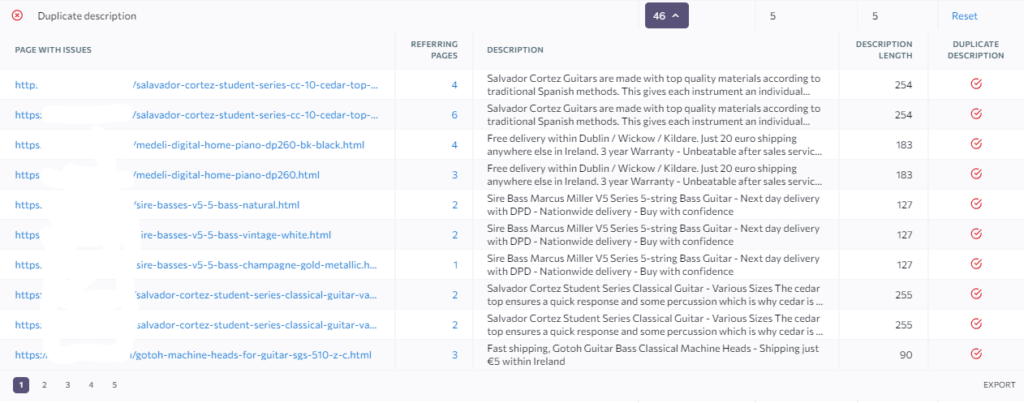
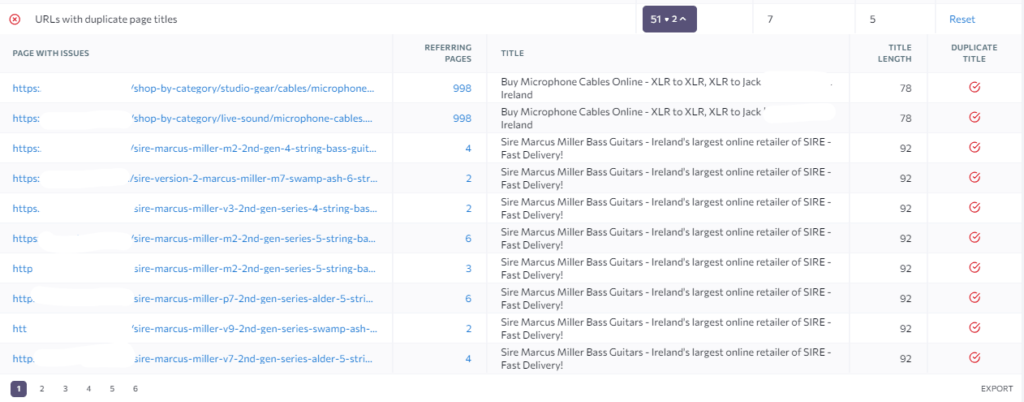
51 site pages have duplicate titles, and 46 contain duplicate <description> tags. Additionally, 211 pages lack <description> data. Duplicate or missing <title> and <description> tags hinder search engines from determining the relevance of a page to specific search queries. Such pages are less likely to rank well and may have reduced click-through rates in search results.
Slow page loading speed

The website’s pages are loading too slowly, negatively impacting user behavior. If a page takes too long to load, visitors are likely to leave and go to another site. Moreover, page loading speed is a significant factor in Google’s ranking algorithm. The following actions should be taken to improve speed:
- Optimize JS/CSS (minify, compress, and reduce unused CSS/JS)
- Reduce the impact of third-party code
- Serve static assets with an efficient cache policy
- Avoid excessive DOM size
- Set up back/forward cache (bfcache)
Performance

Cumulative Layout Shift (CLS) measures any shift in page visual elements during loading, based on data from the Chromium browser. To reduce layout shifts and improve CLS, set explicit width and height attributes on image elements.
Conclusion of eCommerce SEO Audit
This eCommerce site can significantly boost its organic traffic by implementing a systematic approach to search engine optimization. Over 10–16 months, an increase in traffic of 27–40K is anticipated each month. This prediction is based on a competitor’s (https://www.**********.ie) traffic analysis, which shows comparable levels of organic traffic.
eCommerce SEO Audit Services: What Tasks Are Included?
WebMeridian’s team of SEO experts outlines the comprehensive range of tasks included in our eCommerce SEO audit services. The table below provides an approximate estimate of the time spent on each task, acknowledging that the actual hours may vary depending on factors such as eCommerce website size, technology, and the specific nature of the online store. Please note that this list of eCommerce SEO audit services is not a common one but is uniquely tailored and approved by WebMeridian to ensure the highest quality standards.
| Tasks | Details | Estimate (Hours) |
|---|---|---|
| Free eCommerce SEO Audit | Includes a report on the main errors and brief recommendations for their elimination. | 2-3 |
| Detailed eCommerce SEO Audit | Conducting a full audit (covering more than 130 parameters) and preparing a comprehensive report with a description of the issues and recommendations. | 16-20 |
| Technical Tasks | Preparation of technical specifications for developers, copywriters, and other specialists to address identified errors. | 25-40 |
| Technical Support | Consulting with developers, copywriters, and other specialists on how to resolve errors, and checking the implementation of technical specifications. | 10-15 |
| Repeated eCommerce SEO Audit | An eCommerce SEO audit was conducted after major technical changes to the website, which may introduce new technical errors. | 3-7 |
Optimize Your Website Properly
Gain valuable insights and recommendations through our comprehensive Magento code audit services. Discover potential areas for improvement and enhance your website's performance with our expert guidance.

How to Define Your Time for an SEO Audit
Conducting an eCommerce SEO audit within established time intervals is a foolproof way to guarantee your shop runs adequately and efficiently. Large and complex shops may require monthly audits. Medium- to small-sized online shops usually need audits more rarely, like once a quarter or twice a year.
There are, however, several factors that indicate you may need eCommerce SEO audit services right away.
- Declining traffic. If you observe a considerable drop in traffic, it can indicate SEO issues.
- Degrading rankings. If your site is losing rankings for vital keywords, it’s time to investigate.
- Algorithms change. If search engine algorithms have sustained updates, you should check whether they have impacted your site’s rankings.
- Redesign or migration. After conducting a site redesign or migration to a new platform, do an audit to guarantee SEO isn’t compromised.
- High bounce rate. Although it may have numerous other roots, a high bounce rate may also indicate a poor UX that needs addressing.
- Technical flaws. Frequent technical troubles like obstructed loading, broken links, or crawl mistakes dictate an audit.
6 Things to Check to Boost Rankings
How to perform an SEO audit to squeeze the maximum benefits from it?
An eCommerce SEO audit process encompasses a set of checks for a multifaceted assessment of the site’s overall health. You need to examine various website components according to your purposes.
Based on our experience, we’ve shaped an eCommerce SEO audit checklist comprising the fundamental areas to evaluate.
Technical SEO
The eCommerce technical SEO audit spans an array of technical health characteristics and aids in matching them with the crawlers’ criteria.
We usually start with a technical analysis, as it underpins further optimization. It evaluates an extensive range of technical parameters, from which we would highlight the following:
- Crawling and indexing
To locate your site on the SERP page, the bots need to first scan and then index it. They crawl each page to identify its content and further locate them in their big registry. With every incoming user query, the bots define the associated pages from the registry and showcase them in the search results.
Therefore, you should allow the bots to scan your pages meticulously and index seamlessly, making your online shop easy to discover by potential attendees.
- Store’s structure
The composition of your eСommerce space impacts the UX and facilitates the job for the crawlers. With a convenient shop structure, you can expect to enjoy these advantages:
- Swift and seamless consumer navigation;
- Straightforward and efficient scanning by the bots;
- A presentation in the SERP as sitelinks.
The latter entails displaying your site with product categories, which brings in more visitors.
- Loading speed
Sluggish sites can impede your ranking and discourage your visitors. You can utilize tools that assess your speeds and advise on how to expedite your online shop. Generally, pages that load from 0 to 2 seconds boast the maximum conversions.
- Domain redirections analysis
In a technical SEO for eCommerce, domain redirection analysis involves inspecting how different domain variations (such as www vs. non-www, HTTP vs. HTTPS) are handled. This check guarantees that all domain options appropriately lead to a unified, canonical version to avoid duplicate content troubles and preserve SEO consistency.
If your domain redirections are done improperly, Google might not display your web shop, leading to a decline in traffic and purchases. Conversely, accurate domain redirections enhance the consumer progress and help bots index the site more effectively.
- URL check
Another parameter adding to your transcendence over the competition is your site’s URL. The respective part of technical SEO for eCommerce involves examining URL formatting, length, and keyword incorporation.
This analysis guarantees that URLs are readable by users, follow SEO best practices, and exclude duplicate or overly complex URLs. Appropriate URLs promote the site’s online prominence, facilitate a user path, and elevate rankings.
- Navigation analysis
Navigation and URLs are intertwined since both reflect the shop’s structure. Navigation, however, encompasses a broader array of parts affecting the consumer’s route throughout the entire store.
Menus, icons, product filters, buttons, links, and other components simplify the trip from page to page and streamline browsing. They also ease scanning and indexing by crawlers that can unobstructedly travel across your space.
- Mobile accessibility
Mobile devices dominate the eCommerce sector. Thus, smartphones provide about 74% of retail site traffic and 63% of online shopping orders. Furthermore, search mechanisms prioritize mobile-responsive sites thanks to their broader accessibility, hence their winning location in the search. Therefore, you should provide a smooth store operation on various screens.
- Robots.txt file
This file lists scanning directions for the crawlers. If it is absent, bots will index all pages, which should not always be allowed. Thus, you may wish to exclude the pages with client data and shopping carts from indexing. Therefore, outline your instructions in Robots.txt, guaranteeing that crawlers will access the necessary components of your shop and omit the ones you’d prefer not to demonstrate in SERPs.
- Sitemap
Another aspect that facilitates crawlers’ navigation, a sitemap guides the crawlers, aiding them in exploring pages at all levels of your eCommerce space. An appropriate sitemap is crucial for new online shops, in particular. Therefore, the availability of an actual XML sitemap improves indexing, enhancing store’s rankings.
- SSL Certificate check
Safety is vital in the digital environment. Users and crawlers equally prioritize secure sites and rely on evidence to be reassured of their security. An SSL certificate provides a safeguarded interaction between a web browser and a server. It’s paramount to obtain a certificate from a dependable source. Ultimately, a safer store will rank higher and raise buyers’ confidence.
Free Magento SEO Audit
Let us analyze your website across 130+ parameters, including security, content, technical health, and loading speed. Receive comprehensive recommendations to eliminate errors.

On-Page SEO
An on-page SEO for eCommerce sites deals more with the content and tags and encompasses several essential parts:
- Title tags and meta descriptions
A title tag is an HTML component displaying the title of a page in search results. A meta description briefly summarizes the page’s main points. Their relevance, clarity, and overall appeal are critical in generating click-throughs.
The optimal length of a title tag is about 50-70 symbols, while a meta description may contain 120-160 symbols. Make yours as impactful as possible to capture readers’ interest and apply your keywords.
- Keywords
Keywords are another core element by which search bots determine your shop’s relevance to a user query. You should identify the appropriate set of phrases used by consumers when they are investigating the goods you sell.
Keywords usually fall into several categories based on their length, topic, search intent, relevance to your subject, and more.
The distribution of keywords across your texts affects your eCommerce store performance and ranking. Include them in meta tags, product descriptions, blog articles, and other parts. However, you should avoid keyword overstaffing as it may lead to poor SERP positions.
- Canonical tags
Canonical tags are HTML components intended to inform bots about the preferred or canonical version of a page when similar content exists. The tags pinpoint crawlers which page to scan and rank, thereby avoiding duplicates.
They also consolidate the page’s authority and link equity into one favored version instead of dispersing it among multiple pages with comparable content. This leads to elevated crawling efficiency and amplified eCommerce performance.
Off-page inspection
The off-page SEO trespasses the boundaries of your eCommerce store. The respective examination targets areas such as backlinks, social media authority, and overall online reputation.
- Backlinks
Backlinks are powerful signals examined by bots. During the analysis, you should assess your existing backlinks and guarantee they originate from reputable resources. Such backlinks will raise your trustworthiness and elevate your eCommerce rankings. Conversely, backlinks from low-authority resources can hinder your reputation; therefore, it’s better to eliminate them.
- Social media authority
Your SM profile and activities likewise impact your online stature. Refine your profiles and continually come up with posts, news, and other information. Interact with your community, address their questions, and analyze what content engages them most of all.
- Negative SEO
A highly undesired occurrence in eCommerce, a negative SEO implies malicious tactics aimed to harm a competitor’s store’s rankings and reputation. These may span low-quality or spammy backlinks, content scraping, fake negative reviews, and other indecent activities to downgrade your authority. Stay informed and forearmed against such attacks.
Local SEO
A local SEO is another component of our SEO audit checklist, which implies an analysis of a brand’s online presence and visibility within local search results. It evaluates an array of on-page and off-page parameters to determine the business’s positioning in local listings.
This kind of SEO audit typically includes an analysis of Google My Business profiles, on-site optimization, local backlinks, online reviews, and other factors that affect your stance in Google Maps and other regional search results. The goal is to reveal operation weaknesses and drive the business’s online authority across regions.
For a local eCommerce performance analysis, ensure the following:
- Your Google My Business profile and local listings contain precise and updated information;
- The content is tailored to the local shop versions, including languages, currencies, contact information, and more;
- Employ schema geographic markup to let search bots explore your geographic location.
UX Audit
A user experience inspection assesses whether your site is straightforward to use and whether the visitors can address their queries promptly and smoothly. The check typically encompasses website visual composition, navigation, architecture, and consumer pathways to conversion.
The purpose is to uncover troubles that may hamper user delight and search rankings, with the consequential refinement of overall operation.
The UX audit examines the following:
- Clear composition and intuitive navigation. The online store’s visual composition and navigation elements are called to guide visitors in their search. The better they lead consumers toward their goal, the more likely the consumers will be to make the purchase.
- The proper work of buttons and links. A consumer’s failure to detect the component leading to the next stage of their journey may cause a consumer’s drop off. Make sure that your visitors have no obstructions on their way to buying your goods.
- Site responsiveness throughout devices. Consumers may use their PC, smartphone, or tablet to access your store. Deliver them a flawless experience on any screen or device.
- Core web vitals. These are influential ranking parameters included in Google algorithms since 2021. They comprise three performance metrics that examine the loading agility, responsiveness, and visual stability of pages. Ensure that yours correspond to Google recommendations.
Brand and Credibility Audit
This type of audit investigates how the online community identifies your brand. It involves examining the online content associated with your brand and assessing its trustworthiness. This component of SEO for an eCommerce site includes:
- Reputation management
Evaluate the number and character of user reviews and ratings, which can influence trust and raise your shop’s ranking. When managing reviews, maintain continual interaction, address queries, and deliver the necessary advice. Encourage consumers to share impressions and information about your goods.
- Content quality
Analyze the value and credibility of the materials on your site. The content should be valuable, helpful, and actual.
- Social proof
Examine or establish your SM profiles and fill them with the appropriate and actual information. Incorporate customer testimonials and case studies to reinforce trust.
Get an eCommerce Expert Consultation
Our Adobe Business Practitioner will audit and optimize your site for robust performance.

How to Set the Right Regularity for an SEO Audit?
The pace of the SEO inspections should be determined individually and can range from about once a quarter to once a year. You should set the optimal time intervals for your analysis according to several factors:
- The size of your store. Extensive and complicated resources may need inspection more often.
- The degree of competition in your segment. Heading eCommerce site rankings in a fiercely competitive niche requires excellent SEO enabled by a higher pace of audits.
- Your marketing strategy. If you plan to grow organic traffic to your shop, you should increase the density of your SEO audits.
Conclusion
Your brand’s stance on the digital landscape largely derives from your reputation through search mechanisms. As long as they favor your eCommerce site, you’ll be on their lists. Your major task is to keep them updated on how to preserve their benevolence.
eCommerce SEO intends to refine your online space for both crawlers and consumers to aid them in discovering what they need. Once you’ve got an understanding of what SEO for an eCommerce website entails, you are empowered to lead your store toward its optimal operation. For your convenience, we’ve covered the fundamental points on how to perform an eCommerce SEO audit efficiently. Our SEO checklist comprises the core parameters you should assess to reveal the weak points of your shop, increase its authority, elevate traffic, and amplify user delight.
Check your eCommerce store performance regularly, and you’ll be well armed to reveal and remove the gaps early and obtain good chances to outperform competitors in the rankings. Let professionals accompany you on this path, as they know all the intricacies and pitfalls of the procedure and can maximize your value.
WebMeridian’s experts specialize in software for eCommerce and are well aware of how to conduct an eCommerce SEO audit. We will align our SEO checks with your particular demands and examine every component that may need fine-tuning.
Book our eCommerce SEO audit service to propel your shop toward the ranking heights and get ready for new visitor flows and larger conversions.
An e-commerce SEO audit is a multi-faceted examination of an online shop to evaluate its welfare and effectiveness. It involves examining several areas including technical, on-page, and off-page SEO, local SEO, UX, and credibility. The audit's aim is to reveal weaknesses to elevate the site's search rankings, facilitate traffic, and drive online sales.
Start by planning the audit process. Establish your goals, identify core parts for assessment, and decide on whether you will hire a professional partner. Based on our SEO best practices checklist, we advise conducting a technical examination first. Then, proceed to the other SEO audit components. Once the inspection is finished, analyze the report and prioritize your actions for improvement.
An SEO audit includes a thorough review of the site's online authority constituents both within the website and beyond. They comprise keyword optimization, site structure, content quality, accessibility across devices, page load speed, backlinks, and social media stance. The audit collects various kinds of data for measuring the performance of an eCommerce store, assessing your brand’s reputation, and revealing issues.


